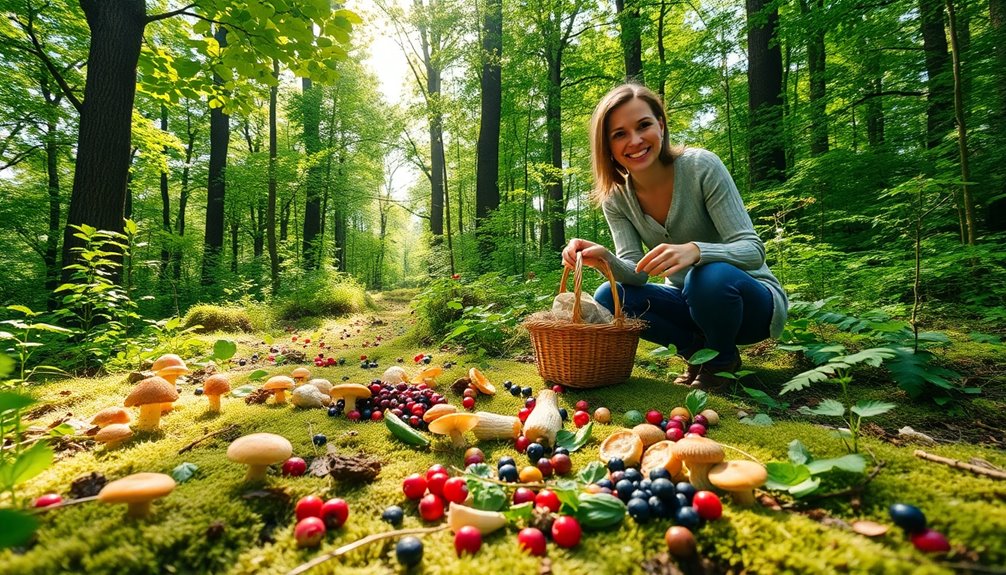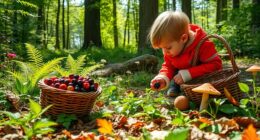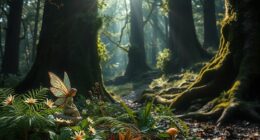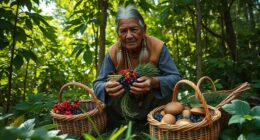Foraging isn’t just a hobby; it’s a means of discovering food and medicine in the great outdoors. It creates a special connection with nature and provides a thrilling opportunity to explore the abundance of the natural world. Whether you’re searching for wild mushrooms, plants, or herbs, foraging is a delightful, eco-friendly way to appreciate the beauty of nature. Join in on the adventure and uncover the wonders of the wilderness!
Starting your foraging journey? You’ll need the right know-how. We’ve put together 10 vital tips for beginners. These hacks make foraging safe and rewarding. You’ll learn how to find and pick nature’s best offerings sustainably.
Ready to enhance your foraging skills? Let’s explore these amazing hacks together!
Key Takeaways:
- Foraging is a rewarding hobby that allows you to gather food and medicine from the wild.
- Approach foraging with caution and knowledge to ensure safe and successful experiences.
- These 10 foraging hacks will equip beginners with the essential tips and tricks.
- Using these hacks will help you navigate the world of foraging safely and successfully.
- By following these hacks, you can enjoy delicious and sustainable foraged finds.
Safety Guidelines for Foraging
Foraging should be fun but safe first. Here are some key tips to keep you safe while you enjoy foraging:
- Confident Plant Identification: Make sure you know the plants you want to forage. Study them through field guides, classes, and online sources. This helps you get better at recognizing them.
- Carry a Basic First Aid Kit: Be ready for any accident. Have a first aid kit with bandages, wipes, tweezers, and meds for allergies.
- Understand Potential Toxins: Some plants could be toxic or cause allergic reactions. Know the risks and warning signs before you go into the wild.
- Obtain Permission: Always ask for permission if you’re foraging on private land or in protected areas. Follow their rules and respect their property.
- Practice Sustainability: Forage with respect for nature. Don’t take too much from one place. Only take what you need and think about the environment.
Follow these safe foraging steps. This way, you can enjoy nature’s gifts without harm to you or the environment.
Common Toxic Wild Plants to Avoid
| Plant Name | Toxicity | Symptoms |
|---|---|---|
| 1. Deadly Nightshade | Highly toxic | Blurry vision, rapid heartbeat, hallucinations, convulsions |
| 2. Poison Hemlock | Extremely toxic | Respiratory failure, paralysis, seizures |
| 3. Foxglove | Toxic | Irregular heartbeat, nausea, dizziness, tremors |
| 4. Monkshood | Toxic | Extreme cooling sensation, numbness, muscle weakness |
It’s always best to err on the side of caution when foraging. If you’re unsure about a plant or mushroom, ask an expert or a seasoned forager. Making sure you’re safe is the most important part of foraging.
Learn in Person or Teach Yourself
There are two main ways to learn about foraging. You can either take classes or teach yourself. Each method suits different learning styles.
Foraging Classes:
Taking foraging classes is a great way to begin. You get hands-on experience, can ask experts questions, and learn important skills. Classes teach you how to identify plants, forage properly, and stay safe.
Choosing herbalism courses is another smart option. They often cover foraging. You’ll learn about wild plants, their uses, and how to add them to your wellness routine.
Benefits of Foraging Classes:
- Hands-on learning experience
- Access to expert guidance
- Opportunity to ask questions
- Learn plant identification
- Understand foraging techniques
- Ensure safety while foraging
Teaching Yourself:
If you like learning on your own, you can teach yourself about foraging. This means using resources to learn about plants you’re interested in.
The internet is full of information on plants, their uses, and foraging tips. Websites and blogs share experiences and advice. Trying out what you learn in your kitchen helps you understand wild foods better.
Benefits of Self-Learning:
- Flexibility to learn at your own pace
- Choose specific plants to focus on
- Access a wide range of online resources
- Experiment and explore in your own kitchen
- Deepen your understanding through personal experiences
The key is to be eager to learn, open to new ideas, and resourceful. With effort and time, foraging can become a rewarding part of your life.

Favorite Foraging Resources
Foraging needs reliable resources. Whether you’re new or seasoned in foraging, some resources are key. They help you know wild plants and herbs. Here are top picks to guide your foraging:
Local Foraging Guidebooks
Many guidebooks cover wild plants, but local ones are best. They share detailed plant info, identification, and safe use tips. Here are some well-loved guidebooks:
- *Northern California Guide to Edible Plants* by Thomas J. Elpel
- *New England Wild Edibles* by Sergei Boutenko
- *Southeast Foraging* by Chris Bennett
Local Foraging Resources
Local herbalists and wild crafters are invaluable. They offer courses, workshops, and tours. Find them at herb shops, markets, or online foraging groups. University extensions are also good for learning about local plants.
Online Herbalism Courses
Online courses are great for deepening your herbalism knowledge. Organizations like The Herbal Academy offer courses from basics to advanced. You’ll learn about plant identification, herbal medicine, and foraging at your pace from home.
These resources will boost your foraging skills. They ensure you forage wild plants and herbs safely and with confidence.

Developing a Relationship with Wild Plants
Learning to connect with wild plants is key to becoming a good forager. When you dive into nature, you learn not just about plants but also bond with nature itself. This bond makes foraging both fulfilling and rewarding.
Begin by learning about plants in your area. Look for books or online resources to help. They can teach you about each plant, its growth, and which parts are edible. This is your first step to confident foraging.

Trying out the tastes and textures of wild plants is fun. Cooking with them lets you discover their uses in meals. This way, you link each plant to your favorite dishes, making them special.
“Foraging is more than food gathering; it’s a journey of discovery and connection. Learning about wild plants and their flavors builds a deep bond with nature.” – Expert Forager
Foraging is more than just picking what you can eat. It’s about seeing the beauty in nature’s small details. Watch the colors and shapes. This will make your foraging more meaningful.
Building a relationship with wild plants teaches you a lot and brings you closer to nature. Each plant becomes a guide on your journey. So, learn from them and let nature lead your foraging adventures.
The Benefits of Foraging for Food
Foraging has many pluses, like cutting down on food waste. It also offers an eco-friendly alternative to regular farming. By choosing to forage, you help the planet and get to enjoy nature’s bounty.
One big plus is how it helps reduce food waste. Regular farming often leads to unused produce, either because of looks or demand changes. Foraging uses the wild’s edible plants and mushrooms, avoiding waste. It cuts down on the need for energy-heavy farming, reducing environmental harm.
Foraging taps into nature instead of just farmed crops. It lets you add new tastes to your diet by using what the wild offers.
Sustainable foraging leaves a small environmental mark. It doesn’t need harmful chemicals or create packaging waste. You can collect food in eco-friendly containers.
Foraging also lessens the need for cooling since wild foods are often used right away. They can also be kept longer through drying or fermenting. This way, it saves energy that would go to refrigeration and transport.
Foraging connects you with nature and supports a greener food source approach. It cuts down waste, offers an alternative to traditional farming, and adopts eco-friendly habits. Enjoying food this way leads to a more mindful and responsible lifestyle.
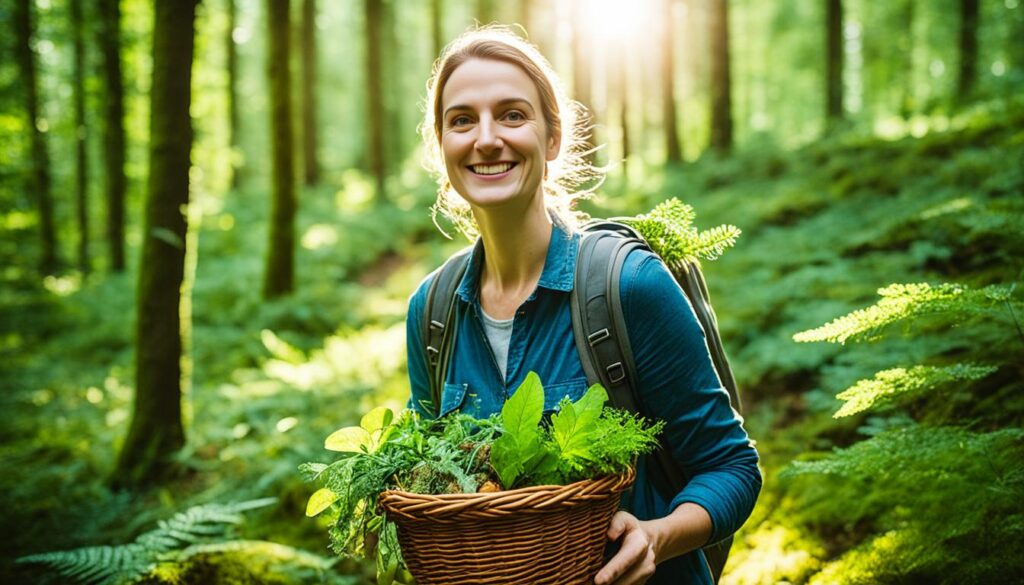
Foraging Vs. Traditional Farming: A Comparison of Environmental Impact
| Foraging | Traditional Farming | |
|---|---|---|
| Land Usage | Relies on natural food sources in the wild, minimal land usage | Requires large areas of land for cultivation, leading to deforestation and habitat destruction |
| Water Usage | Minimal water usage | Consumes significant amounts of water for irrigation |
| Energy Consumption | Low energy consumption, no need for mechanical equipment | High energy consumption for machinery, transportation, and processing |
| Chemical Inputs | No chemical inputs, relies on the natural environment | Relies on pesticides, herbicides, and fertilizers, contributing to water and soil pollution |
| Food Waste | Reduces food waste by utilizing wild food sources | Significant food waste due to surplus production, cosmetic imperfections, and fluctuations in demand |
Foraging in October/November
October and November are amazing for seasonal foraging. These autumn months bring us loads of wild mushrooms, nuts, and berries. Let’s explore what you might find:
Wild Mushrooms
The forest floor is full of edible mushrooms in fall. Keep an eye out for these kinds:
- Blewits
- Waxcaps
- Milkcaps
- Cow boletes
Nuts and Berries
Finding tasty nuts and berries is another highlight of foraging during these months. Look for these treats:
- Sweet chestnuts
- Sloes
- Crab apples
These wild finds are not just food. They are a chance to get creative in the kitchen. The flavors and textures of mushrooms, nuts, and berries can make your cooking stand out.
Foraging in October and November brings nature’s abundance into your hands. It’s an adventure of finding and loving autumn’s flavors.

| Forageable Items | October/November |
|---|---|
| Wild Mushrooms | Blewits, Waxcaps, Milkcaps, Cow boletes |
| Nuts and Berries | Sweet chestnuts, Sloes, Crab apples |
Foraging Safely
Foraging is fun and rewarding if done safely. To enjoy it, learn to forage safely, identify plants well, and use your senses. This way, you lower risks and get the most from nature.
Safe Foraging Practices
For safe foraging, follow important guidelines. These keep you and nature safe while you explore.
- Identification is key. Use guides, take classes, and check online to know plants and fungi.
- Some plants can be harmful. Learn about them to avoid risks like toxins or allergies.
- Forage responsibly. Take only what you need. This helps plants regenerate and supports the ecosystem.
- Always get permission to forage on private land. This respects the landowner and maintains good relations in the foraging community.
Sharpening Your Identification Techniques
Knowing how to identify plants and fungi correctly is crucial. Here’s how to get better at it:
- Local field guides are great. They show specific native plants, which makes identifying easier.
 Workshops with experienced foragers offer hands-on learning. They boost your skills and offer expert advice.
Workshops with experienced foragers offer hands-on learning. They boost your skills and offer expert advice.- Online, you can find detailed plant descriptions and pictures. Plus, forums provide a place to ask for help.
Engaging Your Senses in Foraging
Using all your senses, not just sight, is essential. It adds to safety when deciding on a plant or fungi.
- Touching parts of a plant gives you clues about its edibility.
- A good smell may mean a plant is good to eat. But, a bad smell often means it’s not safe.
- Hearing can help too. Certain animals or insects signal a good foraging spot.
While your senses are helpful, always be careful. Only taste when you’re sure about a plant’s safety. Remember, safety comes first in foraging.
Benefits of Foraging for Reducing Food Waste
Foraging connects us with nature and lets us explore the wild’s riches. It’s a key method for reducing food waste and lowering our eco-footprint. By practicing sustainable foraging, we make a big impact in the food waste fight. This helps create a sustainable future.
The Environmental Impact of Traditional Farming
Traditional farming and food processing harm the environment. They use lots of energy, water, and land. Also, the making, packing, and moving of groceries adds to packaging waste. Foraging cuts down on our carbon footprint by skipping these usual steps.
Foraging allows you to utilize natural resources that would otherwise go unused, while also contributing to a more sustainable and conscious way of obtaining food.
Sustainable Foraging Practices
Sustainable foraging means picking wild food without harming its future supplies or homes. It’s about taking only a little, following rules and seasons, and not taking too much. This way, foragers help keep ecosystems in balance and save biodiversity.
“The act of foraging not only nourishes our bodies but also nourishes the environment, creating a harmonious relationship between humans and nature.”
Minimizing Food Waste
Foraging helps us waste less food. Getting food from nature means we skip a lot of packaging and cooling. Plus, we use plant parts often thrown away in usual farming. This reduces food waste and encourages a more eco-friendly way of eating.
“By foraging, we are not only reducing food waste but also rediscovering the natural abundance that surrounds us, fostering a deeper appreciation for our environment and the resources it provides.”
| Benefits of Foraging for Reducing Food Waste |
|---|
| Reduces the environmental impact of traditional farming practices |
| Minimizes packaging waste and the need for refrigeration |
| Promotes sustainable foraging practices and protects biodiversity |
| Utilizes natural resources that would otherwise go unused |
| Contributes to a more conscious and sustainable approach to food |
By adding foraged foods to our meals and following sustainable foraging habits, we can cut down on food waste, lessen our eco-impact, and live more sustainably. Let’s enjoy the wild’s beauty and use its resources wisely for our good and our planet’s.

Foraging Instagram Accounts to Follow
Instagram is full of inspiration for foragers. It connects you to a lively community. You can find guidance as a beginner or new ideas as an experienced forager. Follow these amazing accounts for tips, recipes, and insights into foraging.
@the_gardencottage
@the_gardencottage showcases beautiful photos of edible plants and dishes. Their feed is full of foraged ingredients turned into delicious recipes. It highlights the wonderful tastes nature provides.
@thewildfood
@thewildfood takes you into the world of wild foods. You’ll see images of vibrant mushrooms and herbs. Through their posts, gain knowledge on plant ID, sustainable foraging, and recipe ideas.
@totallywilduk
For those foraging in the UK, @totallywilduk is perfect. It focuses on British plants and animals. You’ll find tips for each season, plant facts, and how to use wild ingredients.
@blackforager
@blackforager promotes diversity in foraging. It looks at foraging from different community perspectives. There’s lots of knowledge, stories, and cultural insights related to foraging.

Instagram’s foraging community offers knowledge and connects you with people who love nature. Follow these accounts to broaden your foraging skills. Discover the wonders nature has in store.
Recommended Foraging Books
Looking to learn more about foraging? A great foraging book is a key tool. Below are some top picks that discuss how to identify and prepare wild foods.
A Guide to Identifying, Harvesting, and Preparing Wild Edible Plants by Samuel Thayer
Samuel Thayer’s book is a thorough guide. It provides detailed info on finding, picking, and cooking wild plants. With clear photos and descriptions, this book is great for any forager’s collection.
It suits both newbies and pros in foraging. It’ll grow your knowledge on wild plants. Plus, it’ll make you more confident in foraging for many healthy foods.
The Urban Forager: How to Find and Cook Wild Food in the City by Wross Lawerence
“The Urban Forager” by Wross Lawerence is perfect for city folks. It shows how to find and cook wild city plants. You’ll be amazed by the edible plants in urban areas.
No matter if you’re in a big city or a small town, this book is inspiring. It makes you see your environment with fresh eyes and creativity.
Edible Mushrooms: A Forager’s Guide to the Wild Fungi of Britain and Europe by Geoff Dann
If mushrooms interest you, check out “Edible Mushrooms” by Geoff Dann. This book dives into identifying and picking safe wild mushrooms in Britain and Europe. It’s filled with useful descriptions and pictures.
This guide is helpful for both new and skilled mushroom foragers. It’ll broaden your mushroom knowledge. Also, it’ll make your mushroom hunting safe and fruitful.

Good foraging books can really improve your foraging experience. The mentioned books offer insights on finding edible plants and mushrooms. With these books, you’re ready to explore nature and forage successfully!
Conclusion
Foraging is a fun and sustainable hobby that you can enjoy safely. Just follow some rules, learn from pros, and get to know wild plants well. This way, you’ll get good at finding food in the wild.
Foraging brings you closer to nature and has many perks. It helps cut down on food waste and the environmental harm from regular food production. When you forage, you help our planet a lot.
With the right tips and care, foraging is amazing. You might look for wild mushrooms, pick berries, or find plants you can eat. It’s a great way to really see what nature offers. Start foraging now and see what you can discover!




